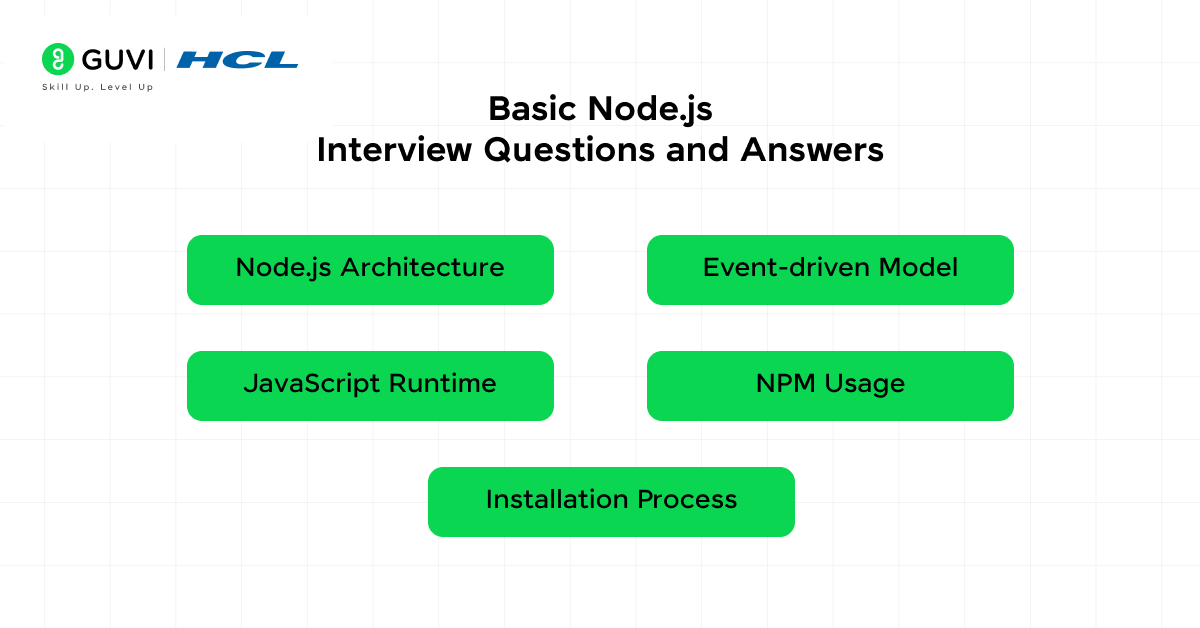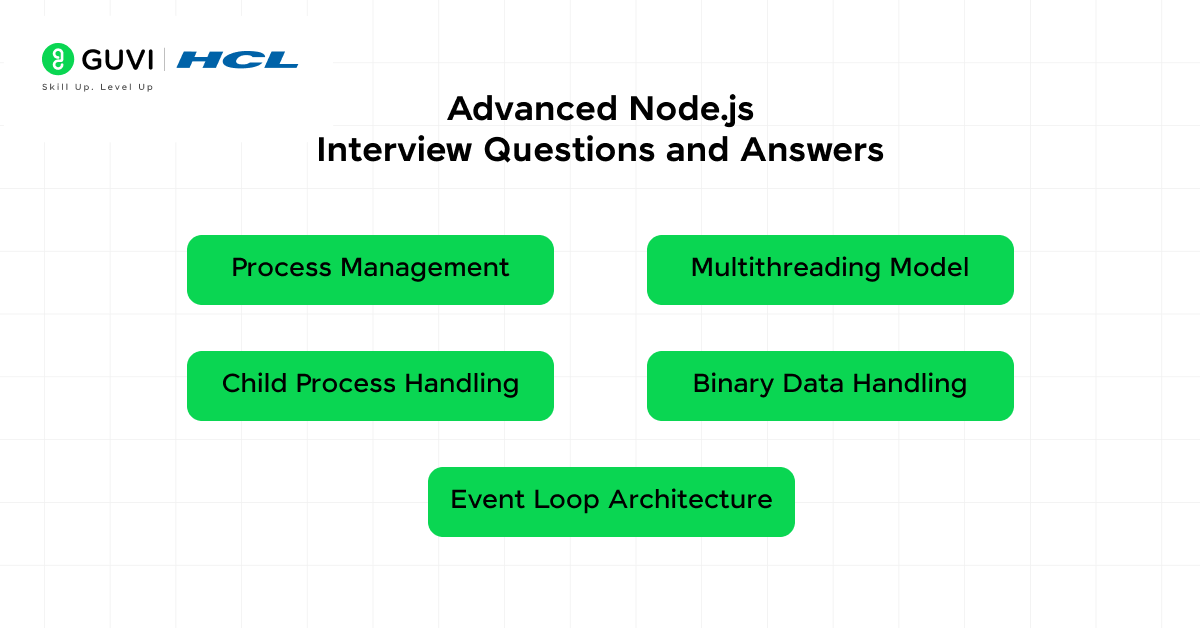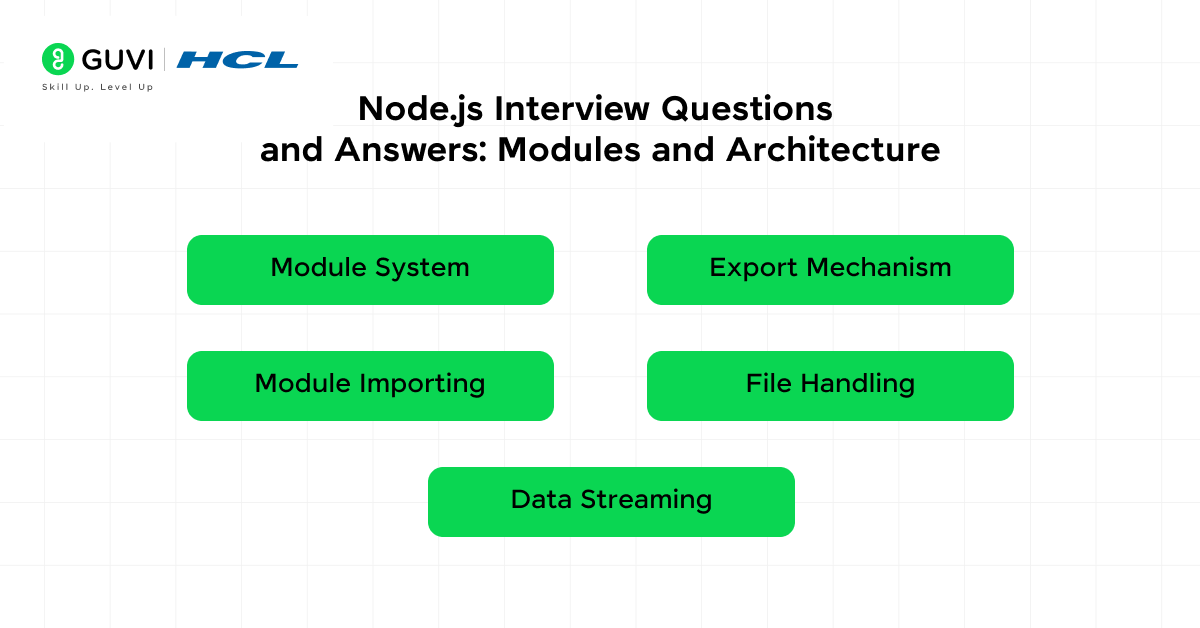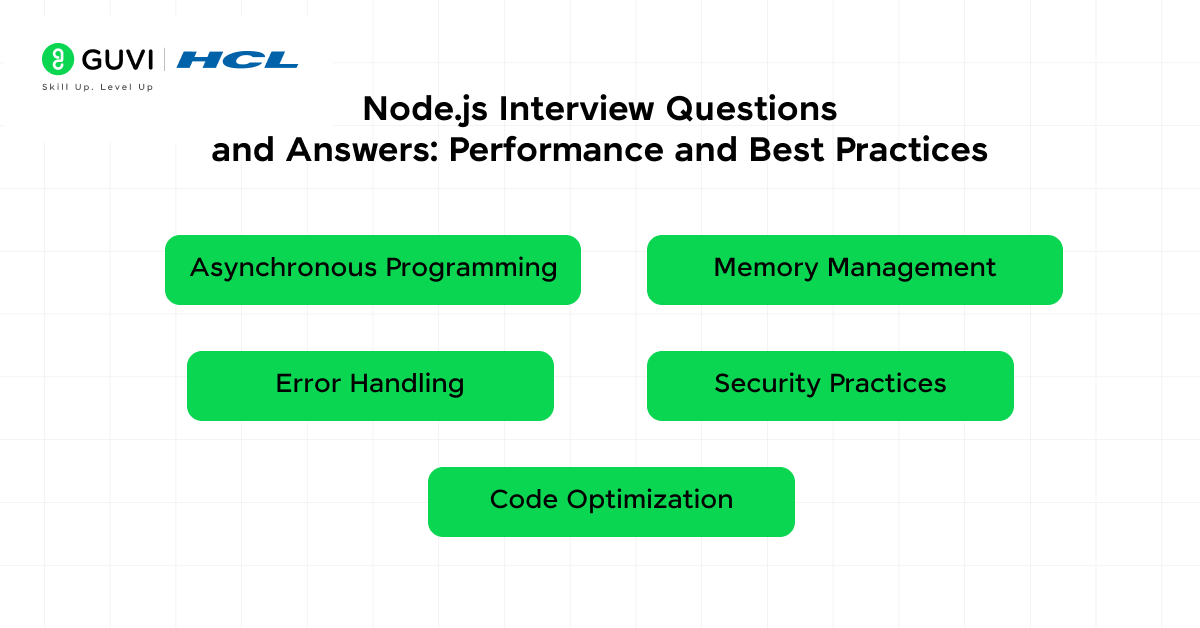
Top 30 Node.js Interview Questions and Answers for All Levels
Oct 10, 2025 8 Min Read 2239 Views
(Last Updated)
Preparing for Node.js interviews requires a thorough understanding of this popular server-side platform. Node.js has gained tremendous traction in the development community, with demand for full-stack developers growing faster than other tech roles.
And with the immense amount of resources on the internet, I know that preparation can be pretty confusing. Hence, I’ve drafted this article after immense research.
Here, you’ll find the top 30 Node.js interview questions and answers spanning all difficulty levels to help you prepare effectively. From fundamental concepts for beginners to complex topics for senior developers, you’ll find concise, easy-to-understand explanations that highlight Node.js’s key features—including its event-driven architecture, cross-platform compatibility, and the powerful ecosystem of over 50,000 packages available through NPM. Let’s begin!
Table of contents
- Basic Node.js Interview Questions and Answers
- What is Node.js?
- Why is Node.js popular?
- How does Node.js work?
- What is the difference between JavaScript and Node.js?
- What are the key features of Node.js?
- What is NPM?
- How do you install Node.js?
- Intermediate Node.js Interview Questions and Answers
- What is the Event Loop in Node.js?
- What is a callback function?
- What are Promises in Node.js?
- What is the difference between setTimeout and setImmediate?
- What is the use of process.nextTick()?
- What is the role of package.json?
- What is the difference between synchronous and asynchronous functions?
- Advanced Node.js Interview Questions and Answers
- What is clustering in Node.js?
- What are worker threads?
- What is the difference between spawn() and fork()?
- What is the buffer class in Node.js?
- What is the reactor pattern?
- What is the role of libuv in Node.js?
- Node.js Interview Questions and Answers: Modules and Architecture
- What are Node.js modules?
- What is module.exports?
- What is require() in Node.js?
- What is middleware in Node.js?
- What is the use of the fs module?
- What are streams in Node.js?
- Node.js Interview Questions and Answers: Performance and Best Practices
- How to improve Node.js performance?
- What is a memory leak, and how can to avoid it?
- How to handle errors in Node.js?
- What are some common security practices in Node.js?
- Concluding Thoughts…
Basic Node.js Interview Questions and Answers
Mastering the fundamentals is crucial when preparing for Node.js interview questions. Let’s explore the essential concepts you need to know to build a strong foundation.

1. What is Node.js?
Node.js is an open-source, cross-platform JavaScript runtime environment that executes JavaScript code outside a web browser. Built on Chrome’s V8 JavaScript engine, it allows developers to use JavaScript for server-side scripting. Essentially, Node.js is neither a programming language nor a framework—it’s an environment that helps in running JavaScript on the server side.
2. Why is Node.js popular?
Node.js has gained immense popularity for several compelling reasons:
- Easy to learn: Its JavaScript foundation makes it accessible for web developers
- Highly scalable: Capable of handling numerous simultaneous connections with high throughput
- Speed: Non-blocking thread execution ensures faster and efficient operations
- Rich ecosystem: Access to over 1 million packages in the NPM registry
- Unified language: Frontend and backend can be managed with JavaScript, streamlining development
- Cross-platform: Works across Windows, Linux, macOS, and more
3. How does Node.js work?
Node.js operates on a unique architecture that sets it apart from traditional servers:
- Uses an event-driven, non-blocking I/O model that makes it lightweight and efficient
- Runs a single-threaded event loop to handle multiple concurrent requests
- When a client sends a request, it’s added to an event queue, processed by the event loop
- For time-consuming operations like file reading, Node.js doesn’t wait but continues processing other requests
- Once an operation completes, a callback function is triggered to handle the result
4. What is the difference between JavaScript and Node.js?
Though related, JavaScript and Node.js serve different purposes:
| JavaScript | Node.js |
| Primarily runs in browsers | Runs on the server-side |
| Can manipulate DOM and access browser APIs | Full access to the file system and server capabilities |
| Limited by browser compatibility | Control over the environment and version |
| No direct file system access | Full access to file system and server capabilities |
| Uses ES Modules system in modern browsers | Supports both CommonJS and ES module systems |
5. What are the key features of Node.js?
Node.js comes with several distinctive features that make it a powerful choice:
- Asynchronous and event-driven: APIs never block, the server moves to the next API after calling it
- Single-threaded but highly scalable: Uses event looping for non-blocking responses
- Very fast execution: Built on Google Chrome’s V8 JavaScript engine
- No buffering: Applications output data in chunks
- Cross-platform compatibility: Runs on various operating systems
- MIT License: Free and open-source
6. What is NPM?
NPM (Node Package Manager) is the default package manager for Node.js and the world’s largest software registry. First thing to remember, NPM serves multiple crucial functions:
- Manages dependencies of your Node.js projects
- Provides access to over 1 million open-source packages
- Allows installation of specific versions of packages
- Comes bundled with Node.js installation
- Consists of a command-line client and an online registry of packages
- Helps in defining scripts for your project in the package.json file
7. How do you install Node.js?
Installing Node.js is straightforward across different platforms:
For Windows:
- Download the Windows Installer directly from node.js.org
- Run the installer and follow the installation steps
For macOS:
- Using Homebrew: brew install node
- Or download the macOS Installer from node.js.org
For Linux (Ubuntu):
sudo apt update
sudo apt install node.js
Using Node Version Manager (recommended):
- Install nvm first, which allows managing multiple Node.js versions
- Then run: nvm install <version> to install a specific version
- Use nvm use <version> to switch between versions
Choosing the right Node.js version is important—the LTS (Long Term Support) version is recommended for most users as it provides stability.
Intermediate Node.js Interview Questions and Answers
Once you’ve got a handle on the basics, diving into intermediate Node.js interview questions reveals the platform’s true power. Let’s explore the concepts that separate beginners from experienced Node.js developers.

8. What is the Event Loop in Node.js?
The Event Loop is the heart of Node.js that enables non-blocking I/O operations despite using a single JavaScript thread. It works by offloading operations to the system kernel whenever possible, allowing Node.js to handle thousands of concurrent connections efficiently.
The Event Loop follows a specific order of operations through six phases:
- Timers phase: Executes callbacks scheduled by setTimeout() and setInterval()
- Pending callbacks phase: Handles I/O callbacks deferred to the next loop iteration
- Idle/Prepare phase: Used internally by Node.js
- Poll phase: Retrieves new I/O events and executes most callbacks
- Check phase: Runs setImmediate() callbacks
- Close callbacks phase: Executes close event callbacks (like socket disconnects)
Between iterations, Node.js checks if it’s waiting for any asynchronous I/O operations before continuing or shutting down.
9. What is a callback function?
A callback function is a function passed as an argument to another function, which is then executed when a specific event occurs or an operation completes. They’re fundamental to Node.js’s asynchronous programming model.
For example:
fs.readFile(‘/file.json’, (err, data) => {
if (err) {
console.log(err);
return;
}
console.log(data);
});
In this pattern, the anonymous function is the callback that runs after the file reading completes. Node.js commonly uses an error-first callback pattern where the first parameter is reserved for an error object.
While callbacks work well for simple cases, they can lead to “callback hell” with multiple nested callbacks, making code difficult to read and maintain.
10. What are Promises in Node.js?
Promises are objects representing the eventual completion or failure of an asynchronous operation. They provide a more elegant way to handle asynchronous code compared to callbacks.
A Promise exists in one of three states:
- Pending: Initial state, neither fulfilled nor rejected
- Fulfilled: The operation completed successfully
- Rejected: The operation failed
Promises can be chained using .then() and .catch() methods:
doSomething()
.then(result => doSomethingElse(result))
.then(newResult => doThirdThing(newResult))
.catch(error => handleError(error));
This approach avoids callback nesting, improves readability, and provides better error handling through the chain.
11. What is the difference between setTimeout and setImmediate?
Both functions schedule asynchronous execution of callbacks, but behave differently in the Event Loop:
| setTimeout(fn, 0) | setImmediate(fn) |
| Executes in the Timers phase | Executes in the Check phase |
| Runs after a specified delay | Runs after the current poll phase completes |
| Minimum delay is not guaranteed to be exact | Designed to execute immediately after I/O events |
When called within an I/O cycle, setImmediate() will always execute before any timers. Outside an I/O context, the order is non-deterministic and can vary.
12. What is the use of process.nextTick()?
process.nextTick() is a unique Node.js function that schedules a callback to execute after the current operation completes but before the Event Loop continues to the next phase.
console.log(‘Start’);
process.nextTick(() => {
console.log(‘nextTick callback’);
});
console.log(‘End’);
// Output: Start, End, nextTick callback
Unlike other asynchronous methods, process.nextTick() doesn’t technically belong to the Event Loop. It processes callbacks immediately after the current operation finishes, making it execute more immediately than setImmediate() despite their confusing names.
Use process.nextTick() when you need to ensure a callback runs immediately after the current function completes but before any I/O events are processed.
13. What is the role of package.json?
The package.json file is the heart of any Node.js project, containing metadata about the project and its dependencies. Its key roles include:
- Dependency management: Lists all packages required for the project
- Script definition: Defines custom commands to automate tasks
- Project identification: Contains name, version, description, and author
- Entry point specification: Defines the main file that runs when the package is required
- License information: Specifies how others can use your code
This file is automatically referenced when you run npm install, which downloads all dependencies specified in it.
14. What is the difference between synchronous and asynchronous functions?
In Node.js, the distinction between synchronous and asynchronous functions is crucial:
Synchronous functions:
- Block the execution of code until the operation completes
- Also called “blocking” functions
- Execute sequentially, line by line
- Simpler to read and debug
- Can degrade performance for I/O-heavy operations
Asynchronous functions:
- Don’t block code execution while waiting for operations to complete
- Also called “non-blocking” functions
- Use callbacks, Promises, or async/await to handle results
- Better performance for I/O operations
- More complex flow control
For example, fs.readFileSync() will halt your program until file reading completes, while fs.readFile() allows your code to continue executing while the file is being read.
Node.js performs significantly better when using asynchronous functions for I/O operations, as they allow the server to handle many concurrent requests without waiting.
Advanced Node.js Interview Questions and Answers
Advancing to more complex Node.js interview questions requires understanding the platform’s internal architecture. These advanced Node.js interview questions often separate senior developers from mid-level programmers.

15. What is clustering in Node.js?
Clustering in Node.js enables running multiple Node.js instances that share server ports. Since Node.js runs single-threaded by default, clustering helps utilize all CPU cores on multi-core systems.
The mechanism works through:
- A primary process that acts as a load balancer
- Child processes (workers) created via child_process.fork()
- Workload distribution using either round-robin (default) or direct socket assignment
Implementing clustering can dramatically improve performance—tests show applications handling triple the requests per second and reducing response times by 75% compared to non-clustered applications.
16. What are worker threads?
Worker threads allow parallel JavaScript execution within a single Node.js instance, introduced in Node.v10.5.0 and stabilized in v12.
Unlike clustering, worker threads:
- Share memory through transferring ArrayBuffer instances or sharing a SharedArrayBuffer
- Are ideal for CPU-intensive tasks, not I/O operations
- Run within the same process but in separate V8 instances
As a result, worker threads prevent CPU-intensive operations from blocking the main thread, keeping your application responsive during complex calculations.
17. What is the difference between spawn() and fork()?
Both functions create child processes, yet serve different purposes:
| spawn() | fork() |
| Creates a streaming interface | Creates a communication channel |
| Ideal for binary/encoded data transfer | Best for JSON/XML message passing |
| Doesn’t create a new V8 instance | Creates a new Node.js V8 instance |
| Useful for large data streams (images, logs) | Designed for inter-process communication |
Typically, fork() is what you’ll use when needing worker processes within a Node.js environment.
18. What is the buffer class in Node.js?
Buffer in Node.js represents fixed-length byte sequences, handling binary data that JavaScript alone cannot process efficiently. Essentially, it’s a subclass of JavaScript’s Uint8Array with additional methods.
Key methods include:
- Buffer.alloc(size): Creates a zero-filled buffer
- Buffer.from(data): Creates a buffer from existing data
- toString(): Converts buffer to string
Buffers are particularly useful when working with files, network operations, or any binary data processing.
19. What is the reactor pattern?
The reactor pattern forms the architectural foundation of Node.js. In essence, it’s an event handling pattern where a single-threaded event loop demultiplexes incoming requests to the appropriate handlers.
The pattern follows these steps:
- Application initiates I/O with a handler function
- Event Demultiplexer manages multiple I/O operations
- Event Loop processes items in the Event Queue
- Handlers execute without blocking other operations
This non-blocking approach allows Node.js to handle thousands of concurrent connections efficiently.
20. What is the role of libuv in Node.js?
Libuv is a cross-platform C library that provides the asynchronous I/O foundation for Node.js. Furthermore, it abstracts system-level operations across different operating systems.
Its responsibilities include:
- Implementing the event loop
- Managing the thread pool (default size: 4 threads)
- Providing consistent APIs for networking, file system, and DNS operations
- Handling system-specific mechanisms (epoll on Linux, kqueue on macOS, IOCP on Windows)
Consequently, libuv enables Node.js to deliver consistent performance across platforms while maintaining its non-blocking behavior.
Node.js Interview Questions and Answers: Modules and Architecture
Understanding Node.js modules and architecture forms the foundation for building scalable applications. Most advanced Node.js interview questions focus on these core architectural elements.

21. What are Node.js modules?
Modules in Node.js are self-contained blocks of code that can be exported and reused across projects. They help maintain the DRY (Don’t Repeat Yourself) principle and organize complex logic into manageable chunks. Node.js supports three main types of modules:
- Built-in modules: Pre-packaged with Node.js (http, url, path, fs)
- Local modules: Custom JavaScript files you create
- Third-party modules: External packages available through NPM
Modules help break down your application into smaller, focused components, making them more maintainable and easier to debug.
22. What is module.exports?
module.exports is a special object included in every Node.js file by default. It determines what a module exposes to other files when they import it. For instance:
function sayHello(userName) {
console.log(`Hello ${userName}!`);
}
module.exports = sayHello;
Alternatively, you can export multiple functions or values:
exports.getName = () => ‘Jim’;
exports.getLocation = () => ‘Munich’;
Keep in mind that whatever you assign to module.exports becomes the exported value of your module.
23. What is require() in Node.js?
The require() function imports modules in Node.js, following the CommonJS specification. When called, it:
- Reads the JavaScript file
- Executes the code inside
- Returns the exported object
For example:
const fs = require(‘fs’); // Built-in module
const myModule = require(‘./myModule’); // Local module
Node.js caches modules after the first load, improving performance by preventing repeated execution.
24. What is middleware in Node.js?
Middleware refers to functions that access the request (req), response (res), and the next middleware function (next) in an application’s request-response cycle. These functions can:
- Modify request/response objects
- End the request-response cycle
- Call the next middleware function
A typical middleware structure looks like:
const loggerMiddleware = (req, res, next) => {
console.log(`${req.method} ${req.url}`);
next(); // Pass control to next middleware
};
Middleware functions can be chained together, creating a pipeline for processing requests.
25. What is the use of the fs module?
The file system (fs) module provides file operations functionality in Node.js. It’s a built-in module that allows you to work with files on your server, commonly used for:
- Reading files (fs.readFile, fs.readFileSync)
- Writing files (fs.writeFile, fs.writeFileSync)
- Managing directories (fs.mkdir, fs.rmdir)
- Checking file status (fs.stat)
Most fs methods have both synchronous and asynchronous versions, allowing flexibility based on your application needs.
26. What are streams in Node.js?
Streams are data-handling methods that process data sequentially in chunks rather than loading entire files into memory. They’re particularly valuable when working with large datasets, making them memory-efficient and time-efficient.
Node.js provides four types of streams:
- Readable: For data consumption (e.g., fs.createReadStream())
- Writable: For data output (e.g., fs.createWriteStream())
- Duplex: Both readable and writable (e.g., TCP sockets)
- Transform: Modify data while reading/writing (e.g., compression)
Given that streams process data in chunks, they’re ideal for handling large files or real-time data processing.
Node.js Interview Questions and Answers: Performance and Best Practices
Performance optimization is critical for production-ready node.js applications. When preparing for node.js interview questions, understanding these best practices can set you apart from other candidates.

27. How to improve Node.js performance?
Optimizing Node.js performance requires attention to several key areas:
- Profiling and monitoring tools: Use Node.js’s built-in V8 profiler or tools like Clinic.js to identify bottlenecks
- Event loop optimization: Avoid blocking the event loop with synchronous operations or heavy computations
- Use worker threads: Offload CPU-intensive tasks to worker threads to keep the main thread responsive
- Implement clustering: Utilize all CPU cores by creating multiple Node.js instances that share server ports
- Optimize database queries: Implement connection pooling and fetch only necessary data
Moreover, proper memory management plays a crucial role in maintaining performance. Monitor CPU usage patterns and implement asynchronous operations wherever possible.
28. What is a memory leak, and how can to avoid it?
A memory leak occurs when your Node.js application doesn’t release memory that’s no longer needed, causing gradual degradation of system resources. In simple terms, it’s orphaned blocks of memory on the Heap not released by the garbage collector.
Common causes include:
- Global variables: Never garbage collected during application lifetime
- Closures: Holding references to large objects
- Event listeners: Not properly detached when no longer needed
- Timers and intervals: Not cleared when no longer needed
To prevent memory leaks, regularly monitor memory usage with tools like Heapdump or memwatch. Additionally, always clear intervals and timeouts, remove event listeners when components are destroyed, and avoid excessive global variables.
29. How to handle errors in Node.js?
Effective error handling improves application robustness and reduces debugging time. Node.js errors fall into two categories:
- Operational errors: Expected runtime problems (invalid input, connection failures)
- Programmer errors: Actual bugs in code (reading undefined properties)
For proper error handling:
- Use try/catch blocks with async/await rather than callbacks
- Create custom Error classes with meaningful properties
- Implement centralized error-handling middleware
- Subscribe to unhandledRejection events
Primarily, avoid displaying stack traces to users and implement proper logging to track errors systematically.
30. What are some common security practices in Node.js?
Security is non-negotiable for production applications. Key practices include:
- Input validation: Sanitize all user inputs to prevent injection attacks
- Set NODE_ENV to production: Reduces information exposed in error messages
- Implement proper authentication: Use secure authentication mechanisms
- Use HTTPS: Encrypt data in transit
- Avoid global variables: They can leak information between requests
- Enable two-factor authentication: For npm and GitHub accounts to protect your code
- Validate dependencies: Regularly check for vulnerabilities in third-party packages
To illustrate, memory leaks and security vulnerabilities often go unnoticed until they cause major issues. Therefore, implement continuous monitoring and adhere to these best practices from the start.
If you want to master Node.js and build scalable web applications, HCL GUVI’s Node.js Certification Course is the perfect launchpad. Designed by industry experts, it offers hands-on projects and real-world interview prep to help you build a successful backend development career.
Concluding Thoughts…
As we conclude, I’m sure that mastering these Node.js interview questions will definitely give you a competitive edge in today’s tech job market. From fundamental concepts like the event loop and callback functions to advanced topics such as clustering and memory leak prevention, your preparation directly influences interview success.
Though interview preparation seems daunting at first, breaking down these concepts into manageable sections, as demonstrated above,e makes the learning process more approachable. Lastly, supplement your knowledge with practical coding exercises to transform theoretical understanding into practical expertise that shines during technical interviews. Good Luck!




































Did you enjoy this article?